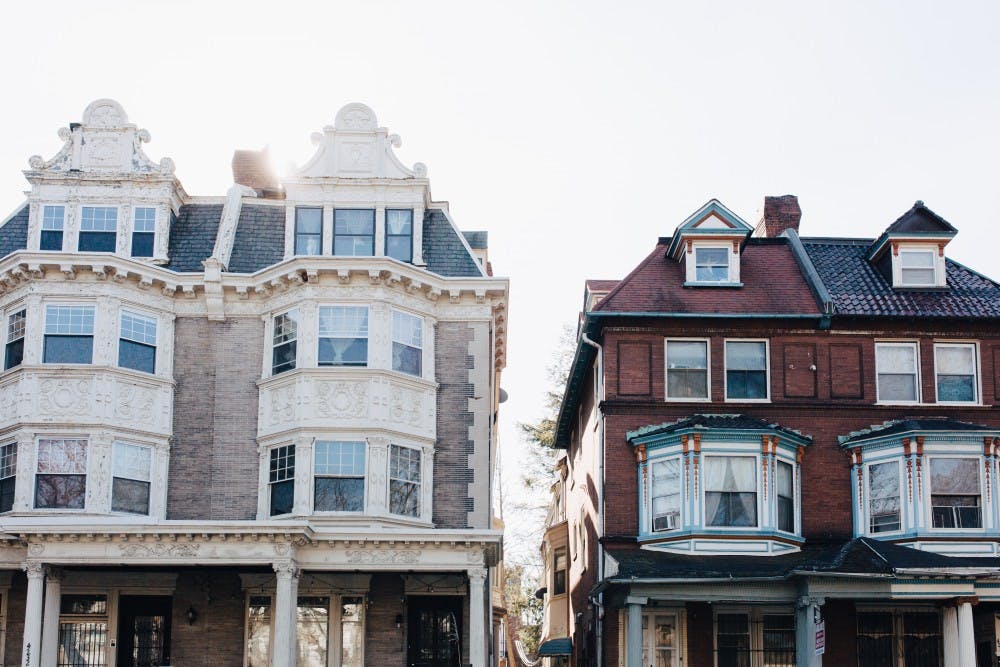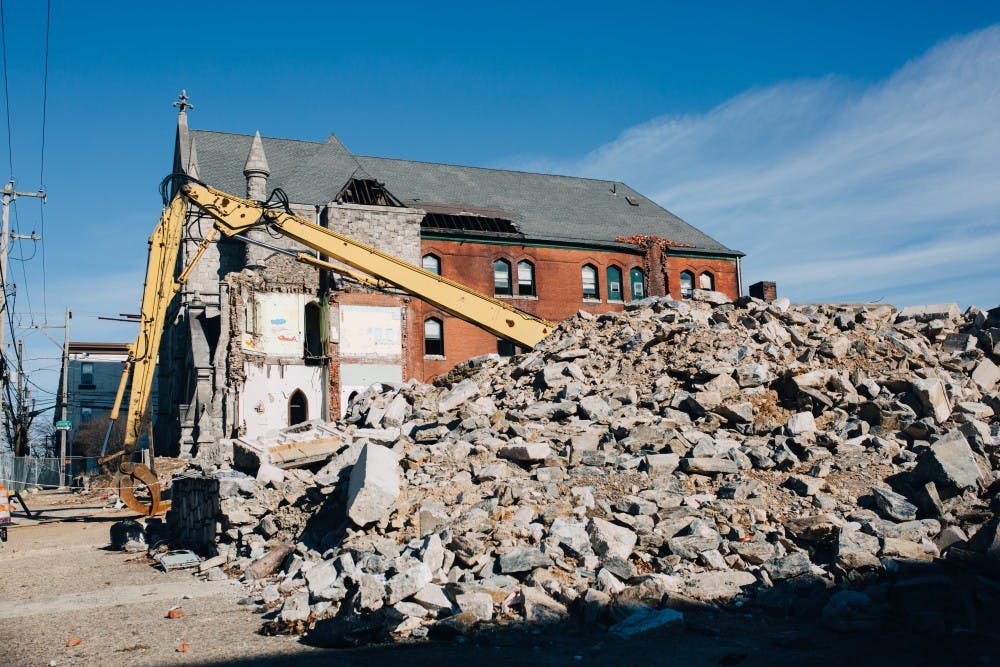Barry Grossbach likens Philadelphia today to the “wild, wild west.” A lot has changed since he moved in 1970 to Spruce Hill, a neighborhood of 19th–century mansions just west of Penn’s campus.
As the city basks in a period of growth, developers from New York and elsewhere are coming in and buying abandoned lots and derelict properties. With over–the–counter demolition permits, they raze townhouse after townhouse, destroy ornate Victorian porches, and massacre lush yards for the sake of producing larger structures. They build cheap vinyl–sided behemoths that yield more rent revenue than the properties they replace ever could.
As long as the city of Philadelphia does not recognize Spruce Hill as a historic district, mass development is likely to continue unimpeded.
Various neighborhood groups have been fighting for such a designation, but it’s a difficult battle, one which pitches old–time residents like Grossbach against property management companies like University City Housing and Campus Apartments.
According to Grossbach, this positioning leads often to conflict. He recalls a phone call with the owner of a local property management company, who told Grossbach in no uncertain terms that Spruce Hill would never be designated as a historic district. As these quarrels continue over whether it is worthy of the city’s protection, Spruce Hill is in danger of falling apart.
But as Bill Groves, the Senior Operations Manager of UCH, says, rapid development in a college town isn’t anomalous. That’s just how it works.
Grossbach says that the owner threatened to rally his tenants to sign up as members of the Spruce Hill Civic Association so they could gain the power to outvote all other residents on community issues, including zoning decisions.
“They don’t want to take the chance of having a historical commission dictate what they can or cannot do, because that means money, and the bottom line is money,” he says.
Grossbach recalls, decades ago, when a speculative developer bought the right side of a house on 45th Street and Kingsessing Avenue in Spruce Hill to eventually turn into apartments. Working with cheap materials and unsound design, his workers took out a load bearing wall that caused the entire structure to require demolition. The family that had lived in the adjoining property for years was forced to relocate. Today, the right–hand lot still stands empty—the developer gave up and moved on after his failure.
Adjoined homes that look like single coherent structures are a marker of Spruce Hill’s architectural legacy. When Philadelphia was expanding westward in the middle of the 19th century, developers sought to take advantage of middle–class design sensibilities that favored the grand and the ornate. They built perfectly symmetrical two–family homes that looked like sprawling mansions to attract wealthy but not too–wealthy city dwellers out from the dense urban center. The addition of electrified trams made this micro–pilgrimage west not only possible but desirable, transforming Spruce Hill into one of the country’s first "street–car suburbs."

Over the next century, each separate side—each "twin"—of a two–family mansion could be sold and resold to different owners, a process that has led to each half decaying and developing independently. The result is an architectural patina.
Take a walk through the neighborhood and you can see houses with only one half of an original porch remaining. You can see awnings split in two, decorative details removed from only one half of a house, different materials and shapes of shingles split perfectly down the middle of a shared roof. You can see houses painted one half white, one half brilliant green.
Paul Steinke, the executive director of the nonprofit Preservation Alliance for Greater Philadelphia, explains the value of the neighborhood: Spruce Hill “is billed as the largest collection of Victorian residential architecture in the country.” Because of its historic significance, in 1998 the entire area was added to the National Register of Historic Places as the “West Philadelphia Streetcar Suburb Historic District.”
But the National Register, though it provides incentives against demolition through tax breaks, has no power over developers who want to convert a nationally designated historic property into something else. Only through protection by the Philadelphia Register of Historic Places can a site in the city be actually insured against the threat of demolition.

On 45th Street, one block further down from the site of the collapsed twin mansion, development progresses like a game of Tetris across from Clark Park. Once a block of Victorian single–family homes and a strip of two–story colonnade–fronted apartments, the street is now punctuated by brick and vinyl student apartment complexes. As original homeowners are either priced out of the neighborhood or slowly die off, the same developer, John Cassidy, has been buying up their properties and placing his new structures down one by one.
Grossbach, who chairs the Spruce Hill Community Association’s zoning committee, has his finger on all development projects going on in the neighborhood. “He [Cassidy] started tearing [existing structures] down regardless of the impact that it had on the properties that were still owner–occupied by people who had lived there for generations,” he says. “He’s tearing down the house that you are adjoined to. And you have nothing you can say about it.”
The apartments reflect the physical reality of the neighborhood: it exists as a parcel of land directly to the west of three universities: Drexel University, the University of the Sciences, and the University of Pennsylvania. With each new wave of expansion, the universities bleed students into homes that in the distant past were dominated by homeowners rather than transient residents and rental property owners.
As someone involved in the rental property industry, Groves does not hold a preservation–focused mentality when it comes to most of University City. “Would there have been any point in protecting the older homes that they bulldozed across from Clark Park?” he asks, referring to a block of student apartments. The answer to Groves, simply, is no.
Though its housing stock used to make up a significant portion of the rental stock in Spruce Hill, University City Housing now only controls a fraction of the market. Its counterpart, Campus Apartments, is by far the dominant force, with an excess of 2,500 units. University City Housing, meanwhile, manages a total number of units in the city closer to 350.
The two companies, however, began together as the same operation in 1967 and still function with the same goals, resulting in a philosophy about urbanism reflected in Groves’ ideas about historic preservation.
Groves has worked for University City Housing since 1986. When he began, he rented almost exclusively to university students. Today, non–students make up nearly twenty percent of his market, a new development in recent years that shows how Philadelphia has become an economically robust city with enough jobs to support new citizens. Spruce Hill, with its strong Penn–supported elementary school, is especially enticing for young families. In a growing city, according to Groves, new naturally replaces the old.

On 43rd and Chestnut Streets, standing at the corner of a block of ramshackle Victorian townhouses, is a beige and dark brick monolith advertising student apartments for $700 per bedroom. At six stories, it dwarves the more compact three–story homes around it. Across the street is the recently demolished Christ Memorial Reformed Episcopal Church, a monolithic gothic structure dating back to 1888.
Further down the street, a six–story wall of yellow building wrap stands stark against the sky, marking another development site. A black plastic tube snakes up the side to twice the height of an adjacent home.
Just ten years ago, such new structures were less commonly built in part due to the city’s zoning code, the collection of laws that controls the residential, commercial, and public use of space, and allows some development proposals to proceed while restricting others.
In 2012, Philadelphia released the widest revision to its zoning laws in over fifty years. An accumulation of previous, small–scale revisions resulted in “a very complicated document that was increasingly unable to meet the demands of an evolving city,” per the new code’s statement of purpose. The code’s revised statement of purpose places the city’s “growth and economic development” as a main goal for the revisions.

Included within the code’s new strategy for achieving that desired growth is the removal of “barriers to enable responsible development to proceed ‘as of right.’” "As of right" refers to the developers’ ability to easily attain the permits necessary to proceed with the plans they have for a given site, so long as those plans conform with how the site is zoned.
In this way, development in Spruce Hill has become a game of maximizing the use of space within the confines of a relatively loose set of laws governing land use. Though largely opposed to local homeowners or even organizations advocating for Philadelphia Historic Register designation, Groves admits that the neighborhood could use some protections. “Is there a role in University City for some form of preservation? Sure there is,” he says. Considering the new boom of demolitions, he concedes: “I don’t think anybody really thought through the implications of the zoning code change.”
Where the Christ Memorial Reformed Episcopal Church was recently demolished and where new six story apartment complexes are rising is a massive zoning district in Spruce Hill marked by the code CMX–4. The Philadelphia Zoning Code defines the marker: “The CMX–4, Center City Commercial Mixed–Use district is primarily intended to accommodate mixed–use development, including a broad range of nonresidential uses, in the Center City area.”
Why is a zoning marker used for Center City dictating land use in West Philadelphia? Perhaps the designation reflects a dream that an expanding Philadelphia will one day have a city center that extends far up its main east to west thoroughfares: namely, Chestnut and Market Streets—something already occurring on the west bank of the Schuylkill River. Considered a godsend by developers in West Philadelphia, the CMX–4 district designation allows for land use in essentially any desired form.
“If you want to build the Eiffel Tower here, you can,” says Grossbach as he points to one of the new apartment complexes.
The lax zoning policy is only one factor contributing the current boom of development in Spruce Hill. Groves explains that “when rents rose to some magical number, it became cost effective for people to buy and knock down existing structures and build new.” By building "by right," by tearing down an older structure and building a new one that conforms to the zoning requirements, “You [can] gain another floor, you can go deeper in the lot,” he says. With more space, investment property owners can install more rent–producing apartment units.
“People didn’t do that 10 or 12 years ago because you couldn’t make any money doing it. Now you can,” emphasizes Groves. “And that’s caused a lot of concern with the local University City bourgeoisie.”
A block north of the Spruce Hill Community Association’s headquarters is an almost unbroken line of Victorian rowhomes. When several went up for sale, developers came in and replaced them with more space–efficient rental structures. Stripped of any now–classic ornamental details, the properties stand out on an otherwise historic street—black–painted fences made of cheap metal partly hide garbage and recycling bins out front.
The destruction of such historic sites are what Steinke and the Preservation Alliance work to prevent. When faced with a property under threat from outside developers, Steinke and his team work to convince those developers of the values of preservation and converted use. “A lot of times they will listen politely and then do what they wanted to do anyway,” he says.
This case–by–case treatment of fragile properties would not be necessary if Spruce Hill in its entirety were designated historic. Municipal designation provides an additional hoop for developers to jump through before being able to touch a protected property.
Today, Philadelphia has twenty–one historic districts with two more in consideration that range in size and character from a strip of nine houses on West Girard Avenue to the wide swath of blocks surrounding Rittenhouse and Fitler Squares. Anyone can propose a historic district, but the process requires a rigorous survey of the properties included within it and a written statement defending the district’s architectural or otherwise cultural significance, with a bibliography attached.
Grossbach has seen the Spruce Hill Community Association produce two separate proposals for neighborhood historic designation over the years of his involvement. “For a volunteer organization, that’s an enormous task,” he says. The city approved neither proposal.
“Meanwhile, we’re losing buildings,” says Grossbach. “We’re having people coming in, investment property owners, they’re tearing down buildings, they’re building crap.”
Faced with the rejection of two blanket historic district proposals in Spruce Hill, Grossbach and his colleagues have recently been encouraging homeowners in the neighborhood to pursue municipal historic designation on a block–by–block basis. So far, there have been two successes—a block of four ornate red brick monoliths on 42nd Street and Baltimore Avenue and “Satterlee Heights” on the 4300 block of Osage Avenue.
Nominating historic districts on a block–by–block basis is politically strategic. Investment property owners are unlikely to run to politicians to complain about the historic designation of a block where they don’t hold property, says Grossbach.
Groves still has a “personal” dissatisfaction with these smaller–scale projects by Spruce Hill’s “historic preservation zealots.” Though Grossbach states that he looks for streets devoid of investment property owner interests, University City Housing actually owns a corner property in Satterlee Heights. Groves says that he knew nothing about the proposal until the day before the hearing at City Hall, when one of his residents came to his office with a letter announcing it.

“And I go to the hearing and what do I see but the woman who moved this whole thing standing up in front of the full committee, saying that she had the approval of the entire block. And I had to stand up and say, ‘Well, you don’t have mine.’”
The whole experience is representative for Groves, demonstrating the lengths to which individual property owners will go to protect their interests and their block’s interests. “That’s kind of the way they operate. They don’t want input from people that are renting,” he says.
“They’re all fighting over their personal spot. Does Barry really care what happens on the 3900 block of Pine [Street]? No, he doesn’t.”
On a macro–level, Groves is against historic designation in Spruce Hill because he sees preservation on a neighborhood scale as unrealistic in a growing city. “On a personal level, I don’t like the idea that a small number of homeowners can impose their will on the greater whole. And that’s certainly what it is,” he says.
Groves finds his own appreciation of historic architecture at odds with his role as a manager of investment properties, though. He cites a row of “stunning” homes on the 4500 block of Larchwood Avenue. “How do you stop somebody from New York coming down, buying them, bulldozing them, and building something out of Dryvit and plastic?” Groves doesn’t have an answer, and can only hope that his favorite properties escape untouched while the ones he manages remain free from the restrictions of historic designation.

For now, Grossbach will continue to encourage homeowners to apply for designation from the Philadelphia Historical Commission. With this plan in action, he’s unworried about the future state of Spruce Hill, if frustrated over the current wave of development and longstanding political stagnation he continues to see. “I’m a city person,” he says. “Cities are cyclical, and you’ve got to work with them. And anybody who thinks that you can declare victory is crazy, because cities, you know, there are ebbs and flows to them. Cities are up and then they’re down.”
Groves prophecies a distinctly different vision for the neighborhood: “I think even in five years it’s going to look a lot different.”
With no neighborhood–wide historic designation from the city, Spruce Hill will continue to develop its newest layer of architecture, adding 21st–century features to a landscape already marked by its eclecticism.
